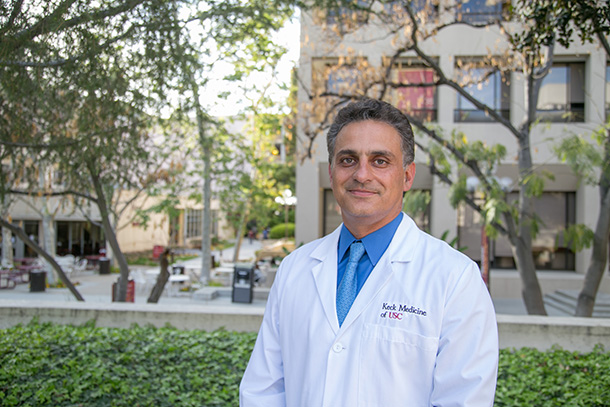Two years ago, Alidad Ghiassi, MD, assistant professor of clinical orthopaedic surgery at the Keck School of Medicine of USC and a specialist in hand and upper extremity surgery in the Department of Orthopaedic Surgery at Keck Medicine of USC, got an unexpected call from a former colleague, Kodi Azari, MD. Azari, who is the director of the hand transplant program at the University of California, Los Angeles (UCLA), was gathering a team of expert surgeons to perform a hand transplant, and he wanted Ghiassi to participate in this exceptionally rare procedure.
“My immediate answer wasn’t a quick yes or no,” Ghiassi said. “I had to think about the impact a hand transplant would have on the patient over the long term, and I wanted to consult with the people close to me about it first.”
Once Ghiassi learned more about the patient and his fierce commitment to the process, the answer became obvious.

Alidad Ghiassi, second from left, reunites with the hand transplant patient and other members of the surgical team. (Photo/Courtesy UCLA)
“The patient didn’t have the use of his hands or legs, and he wasn’t able to care for himself,” he said. “I realized that the procedure could substantially improve the quality of his life and increase his independence.”
What Ghiassi didn’t know was that his decision to be a part of the hand transplant would transform his own life, too.
Ghiassi, Azari and the UCLA hand transplant team began collaborating on mock hand transplant operations at Keck Medicine of USC and at Ronald Reagan UCLA Medical Center. Ghiassi, whose specialty is wrist and upper extremity surgery, would be responsible for preparing the donor arm for the transplant and attaching the donor’s bones to the recipient’s bones. He and the other surgeons practiced marking structures in the arm and preparing the tissue for transplant. They figured out all of the details of attaching the bones together in a biomechanically stable way — including how long the bones should be, how the bones would rotate, and how and where to reattach the nerves. It was a balancing act.
“As we were practicing, the game plan kept changing until we got it right,” Ghiassi said. The surgical team would have one shot at a successful procedure. “If you have to make fixes later, you run the risk of flaring the patient’s immune response and increasing the chance of rejection. It’s really a one-time deal.”
The hand transplant — the second one to be performed in the western United States — took place in October 2016 at UCLA. The surgical team was composed of highly skilled doctors from Keck Medicine, UCLA, the University of California-Riverside and Kaiser Permanente.
At the beginning of the procedure, Ghiassi assisted with carefully preparing the donor’s arm as quickly as possible.
“The clock was ticking. We needed to push along quickly so that the blood vessels could be attached to the patient,” he said. “The sooner you attach the blood vessels, the better the outcome for the patient.”
Ghiassi then helped join the bones from the donor to the patient. Once he completed his part of the surgery, other members of the surgical team stepped in to perform the next steps in the intricate procedure.
The extensive preparation and planning paid off. The procedure went smoothly, without any surprises, Ghiassi said.
“It was like an orchestrated dance.”
Nearly a year after the operation, the patient has made incredible progress. He is independent and can drive a car and can participate in activities like tennis and working out at the gym, Ghiassi said.
But the recipient of the new hand was not the only person whose life was changed by the historic procedure.
“I witnessed someone who entirely depended on others become a fully independent person, all because of his deep commitment to this extraordinarily difficult procedure and its aftercare,” Ghiassi said. As a result of the experience, “I look at the world differently now. I appreciate life more.”
— Erica Rheinschild
A rare and demanding procedure
Orthopaedic surgeon Alidad Ghiassi, MD, provides his insights on hand transplantation and some of the challenges the procedure presents both to patients and doctors.
Q: How common are hand transplants?
A: They’re pretty uncommon. There have been fewer than 100 hand transplants performed worldwide and only two in the western United States. Although the procedure is rare, we are beginning to see some long-term results and are able to tailor the operation to patients’ needs.
Q: What are some of the considerations for having a hand transplant?
A: Not everyone is a candidate for a hand transplant, and the vetting process is extensive. Getting through the actual procedure is just the first hurdle — the bigger challenge comes with having to take immunosuppressive medications for the rest of your life, along with adhering to lifelong follow-up with your doctor. Candidates need unrelenting dedication and a strong social support network to make it successful.
Q: What was one of the unique challenges you faced with this hand transplant?
A: For a hand transplant, the surgeon has to match one person’s bones to another person’s bones. This is much trickier than repairing a fractured bone to its previous state. Getting the length of the bones and relationship of the bones to each other is important; you also want to make sure that the bones rotate properly. Your ultimate goal is to create a stable, natural-looking hand that the patient can start using soon after the procedure.
— Erica Rheinschild


